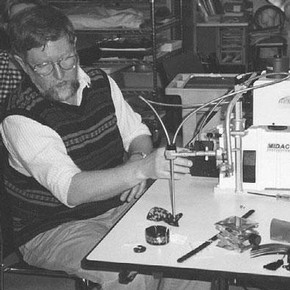Conservation Journal
July 1998 Issue 28
Review of 'Care and Preservation of Modern Materials in Costume Collections'- New York 2-3 February 1998

Figure 1. Scott Williams at work using the portable FTIR spectrometer in one of the studios of the Costume Institute. Photography by Silvia Valussi. (click image for larger version)
During the first months of my research on synthetic fibres made of polyurethanes (elastane), I had the opportunity to attend this symposium, which was held in the fabulous Metropolitan Museum of Art (Met) in New York. I will always remember this experience as one of the most exciting and valuable events in my life, as I found the two day conference very interesting and useful for my studies, and also because it was my first visit to New York.
In the first day, two sessions of presentations were organised in the Uris Auditorium of the Met. After the opening remarks given by the Director of the Costume Institute, a number of designers and conservators (including a free-lance tailor who has recently worked for Versace) filled the whole day with relevant contributions about the wide range of problems encountered by conservators when dealing with modern materials in the dress collections.
The large number of conservators in the audience testifies to both the significant presence of plastics - mostly polyurethane, polyester and polyamide - in twentieth century fashion design and fabrics, and the need for conservators to have an appropriate background. Such a background should consist of information, explanations and guidelines, in order to identify, preserve and care for all the different forms of plastics (fibres, films, adhesives, sheets, etc.) within museum costume collections.
The second day consisted of an all-day seminar on 'Plastics in Conservation Materials & Museum Objects', which was held at the Costume Institute and led by Scott Williams, Conservation Scientist from the Canadian Conservation Institute. Only a limited number of people were entitled to attend this seminar, comprising several conservators and a group of students from the Winterthur Conservation Program in Delaware. After an exhaustive description of the different types of plastics and their properties, the discussion went deeper into the physical, biological and chemical agents that cause deterioration of plastics in museums, as well as the use of polymeric materials in conservation.
In a practical session, a selection of degraded synthetic museum objects - garments, decorations, shoes, combs and bags - as well as polymeric materials normally used in conservation (for example, foams) were analysed, and the evidence of degradation was discussed. The easy determination of the chemical composition of the plastic components of the objects was identified as a critical requirement for their proper preservation and treatment. The use of a portable Fourier Transform-Infrared Radiation (FTIR) spectrometer with a fibre optic sampling probe permitted a fast and precise identification of the components in the objects considered, and some hypotheses on the causes of degradation were formulated.
The instrument consists of separate modules: the Infrared Radiation (IR) source is a MIDAC illuminator FTIR Spectrometer, but the critical part of the instrument is the REMSPEC Mid Infrared Fibre-Optic Immersion Probe System which delivers the IR radiation from the illuminator to the sample, and collects the reflected radiation from the sample for delivery to the detector. This instrument is light weight, compact and mobile. It can be lifted by one person and mounted on a laboratory cart for moving around museums, galleries and storage areas.1
I feel that this experience at the Met has given me a significant return, fulfilling the great expectations I had before my departure to New York. I made useful contacts, I experienced first-hand the problems of degradation in the dress collections, and I also learned more about communicating with people who do not have a scientific background, but do need and request scientific explanations. I have also realized how twentieth century textile technology has been bringing together fashion, design, engineering and science. Synthetics are now much more than cheap substitutes for natural fibres: they feel good, perform well and look 'out-of-this-world' - literally.
Reference
1. Further information about this portable FTIR spectrometer can be obtained by contacting R. Scott Williams by e-mail at scott-Williams@pch.gc.ca.
July 1998 Issue 28
- Editorial - Education and Training
- An Exploration of the original appearance of Nicholas Hilliard's portrait miniatures using computer image manipulation
- Outer Limits: The Ups and Downs of Being a Student on a Collaborative MA Couse
- Archaeopteryx - a wing and a prayer
- Internships at the V&A
- Six-month Internship in Decorative Surfaces
- Life as an Intern
- The External Examiner
- Out of the Frying Pan...
- Report of a Research Trip to Tokyo and Kyoto in January 1998 founded by the Great Britain Sasakawa Foundation
- Review of 'Care and Preservation of Modern Materials in Costume Collections'- New York 2-3 February 1998
- Printer Friendly Version